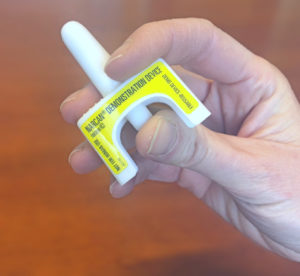Save a life from opioid overdose
A guide to the life-saving medication Naloxone
What is Naloxone?
Naloxone is the life-saving antidote for opioid overdose. People oftentimes refer to the medication by the brand name, Narcan®. Naloxone reverses the good and bad effects of opioids. When someone is overdosing on an opioid medication like Percocet®, oxycodone, or fentanyl, they will experience decreased breathing, unconsciousness and potentially death. A person can be saved by administering naloxone. The effects of the opioid are reversed and they will start breathing again. The easiest way to administer naloxone outside of the medical setting is to spray it inside the nose, but a nonprofessional can also be trained to give it as an injection in the muscle.

Helping Someone Who May Be Overdosing
How can you tell if someone is overdosing?
If someone is very drowsy or unconscious and non-responsive and you are concerned that they are having an overdose, you can determine if they need naloxone through their responsiveness to certain actions. You can first try to wake or speak to someone unresponsive. To confirm that the person is not just in deep sleep you can perform a “sternal rub” which will most likely wake them. The person may have bluish skin and may be breathing slowly or gasping for air. If signs of overdose are present, call 911 for help and give naloxone. The Naloxone dose can be repeated a second time after 3 minutes if no or minimal breathing or responsiveness.
Will Naloxone hurt someone who is not having an overdose?
No. If the person you are trying to help is suffering from a different illness or a non-opioid overdose and is unresponsive, naloxone will not hurt them. There will be no effect.
Is it painful to come out of an overdose?
Naloxone reverses the good and bad effects of opioids. So, while they may be able to breathe and return to consciousness, they also may be in some withdrawal from not having the drug in their system. For example, if someone uses opioids every day and is given naloxone, they could go into withdrawal and become agitated. Significant agitation is not common. The benefits of giving naloxone outweigh the risks.
Where can I get Naloxone?
Naloxone is available in all Hennepin Healthcare pharmacies and is available without a prescription. Most insurance providers cover Naloxone. It will appear as a medication in the medical record. Our pharmacists will discuss the copay based on your insurance. Hennepin Healthcare pharmacies have free naloxone kits available for uninsured patients.

